Nir Ratner
Jamba-1.5: Hybrid Transformer-Mamba Models at Scale
Aug 22, 2024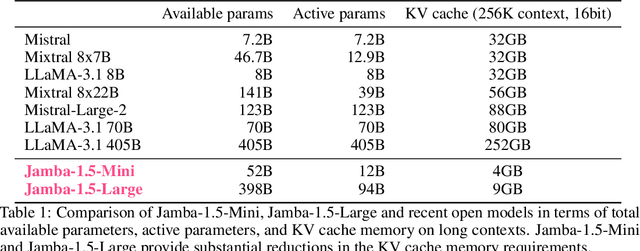
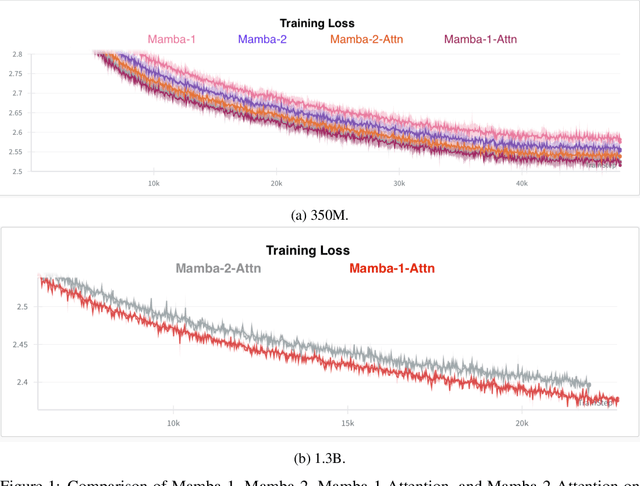
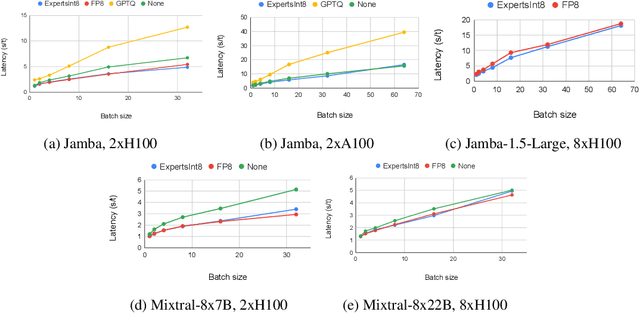
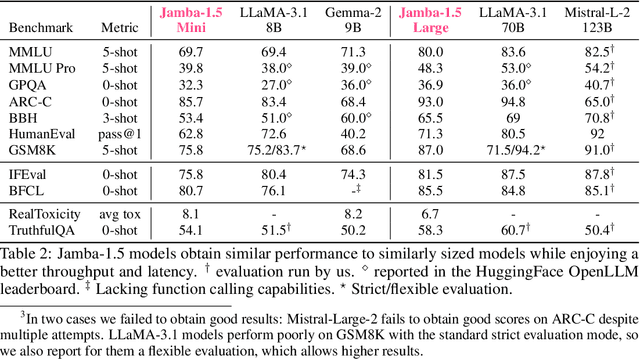
Abstract:We present Jamba-1.5, new instruction-tuned large language models based on our Jamba architecture. Jamba is a hybrid Transformer-Mamba mixture of experts architecture, providing high throughput and low memory usage across context lengths, while retaining the same or better quality as Transformer models. We release two model sizes: Jamba-1.5-Large, with 94B active parameters, and Jamba-1.5-Mini, with 12B active parameters. Both models are fine-tuned for a variety of conversational and instruction-following capabilties, and have an effective context length of 256K tokens, the largest amongst open-weight models. To support cost-effective inference, we introduce ExpertsInt8, a novel quantization technique that allows fitting Jamba-1.5-Large on a machine with 8 80GB GPUs when processing 256K-token contexts without loss of quality. When evaluated on a battery of academic and chatbot benchmarks, Jamba-1.5 models achieve excellent results while providing high throughput and outperforming other open-weight models on long-context benchmarks. The model weights for both sizes are publicly available under the Jamba Open Model License and we release ExpertsInt8 as open source.
Jamba: A Hybrid Transformer-Mamba Language Model
Mar 28, 2024



Abstract:We present Jamba, a new base large language model based on a novel hybrid Transformer-Mamba mixture-of-experts (MoE) architecture. Specifically, Jamba interleaves blocks of Transformer and Mamba layers, enjoying the benefits of both model families. MoE is added in some of these layers to increase model capacity while keeping active parameter usage manageable. This flexible architecture allows resource- and objective-specific configurations. In the particular configuration we have implemented, we end up with a powerful model that fits in a single 80GB GPU. Built at large scale, Jamba provides high throughput and small memory footprint compared to vanilla Transformers, and at the same time state-of-the-art performance on standard language model benchmarks and long-context evaluations. Remarkably, the model presents strong results for up to 256K tokens context length. We study various architectural decisions, such as how to combine Transformer and Mamba layers, and how to mix experts, and show that some of them are crucial in large scale modeling. We also describe several interesting properties of these architectures which the training and evaluation of Jamba have revealed, and plan to release checkpoints from various ablation runs, to encourage further exploration of this novel architecture. We make the weights of our implementation of Jamba publicly available under a permissive license.
Generating Benchmarks for Factuality Evaluation of Language Models
Jul 13, 2023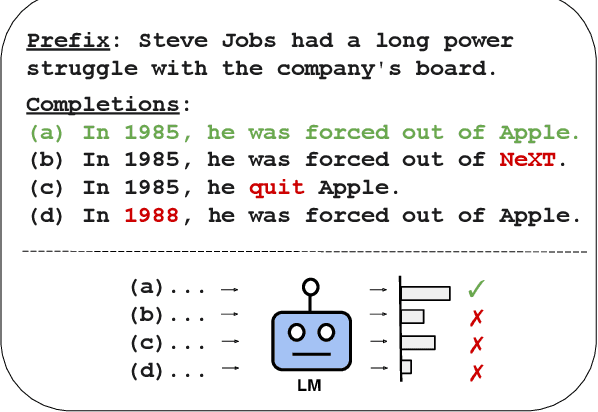
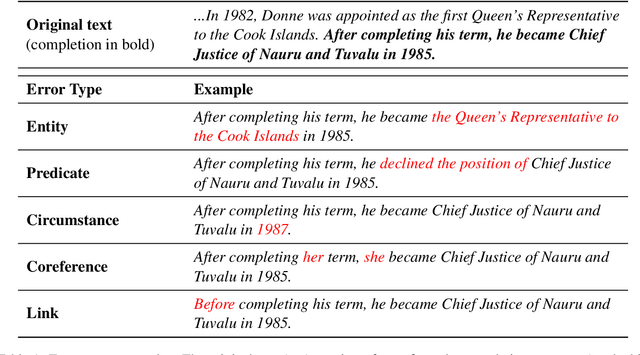
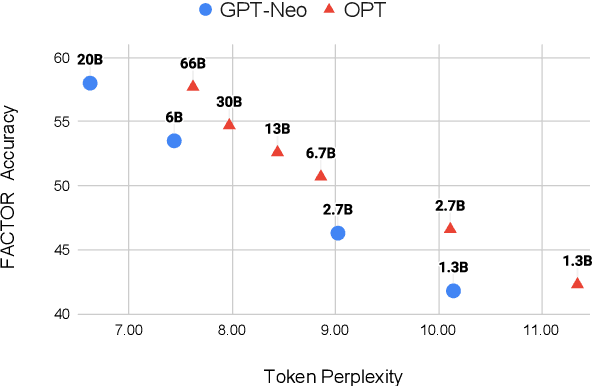
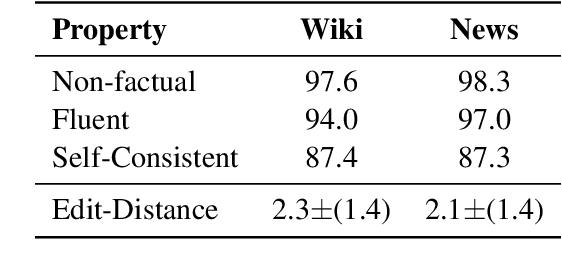
Abstract:Before deploying a language model (LM) within a given domain, it is important to measure its tendency to generate factually incorrect information in that domain. Existing factual generation evaluation methods focus on facts sampled from the LM itself, and thus do not control the set of evaluated facts and might under-represent rare and unlikely facts. We propose FACTOR: Factual Assessment via Corpus TransfORmation, a scalable approach for evaluating LM factuality. FACTOR automatically transforms a factual corpus of interest into a benchmark evaluating an LM's propensity to generate true facts from the corpus vs. similar but incorrect statements. We use our framework to create two benchmarks: Wiki-FACTOR and News-FACTOR. We show that: (i) our benchmark scores increase with model size and improve when the LM is augmented with retrieval; (ii) benchmark score correlates with perplexity, but the two metrics do not always agree on model ranking; and (iii) when perplexity and benchmark score disagree, the latter better reflects factuality in open-ended generation, as measured by human annotators. We make our data and code publicly available in https://github.com/AI21Labs/factor.
Parallel Context Windows Improve In-Context Learning of Large Language Models
Dec 21, 2022Abstract:For applications that require processing large amounts of text at inference time, Large Language Models (LLMs) are handicapped by their limited context windows, which are typically 2048 tokens. In-context learning, an emergent phenomenon in LLMs in sizes above a certain parameter threshold, constitutes one significant example because it can only leverage training examples that fit into the context window. Existing efforts to address the context window limitation involve training specialized architectures, which tend to be smaller than the sizes in which in-context learning manifests due to the memory footprint of processing long texts. We present Parallel Context Windows (PCW), a method that alleviates the context window restriction for any off-the-shelf LLM without further training. The key to the approach is to carve a long context into chunks (``windows'') that fit within the architecture, restrict the attention mechanism to apply only within each window, and re-use the positional embeddings among the windows. We test the PCW approach on in-context learning with models that range in size between 750 million and 178 billion parameters, and show substantial improvements for tasks with diverse input and output spaces. Our results motivate further investigation of Parallel Context Windows as a method for applying off-the-shelf LLMs in other settings that require long text sequences.
MRKL Systems: A modular, neuro-symbolic architecture that combines large language models, external knowledge sources and discrete reasoning
May 01, 2022
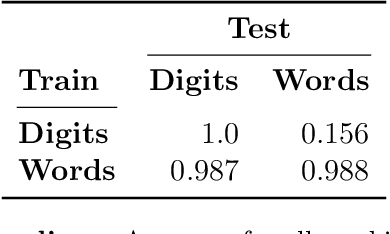


Abstract:Huge language models (LMs) have ushered in a new era for AI, serving as a gateway to natural-language-based knowledge tasks. Although an essential element of modern AI, LMs are also inherently limited in a number of ways. We discuss these limitations and how they can be avoided by adopting a systems approach. Conceptualizing the challenge as one that involves knowledge and reasoning in addition to linguistic processing, we define a flexible architecture with multiple neural models, complemented by discrete knowledge and reasoning modules. We describe this neuro-symbolic architecture, dubbed the Modular Reasoning, Knowledge and Language (MRKL, pronounced "miracle") system, some of the technical challenges in implementing it, and Jurassic-X, AI21 Labs' MRKL system implementation.
 Add to Chrome
Add to Chrome Add to Firefox
Add to Firefox Add to Edge
Add to Edge